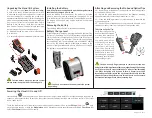
6-6
IM 253710-01E
When the time base is set to [Ext]
Apply a clock signal to the external clock input connector (EXT CLK IN) on the rear
panel that meets the following specifications.
EXT CLK IN
Item
Specification
Connector type
BNC connector
Frequency range
1 kHz to 250 kHz
Input level
CMOS
Minimum pulse width
1
µ
s for both High and Low
CAUTION
Applying a signal to the external clock input connector (EXT CLK IN) that is
outside the 0 to 5 V range may damage the instrument.
Circuit diagram and timing chart of the external clock input
External clock signal
External clock signal
Sampling edge
1
µ
s or longer 1
µ
s or longer
100
Ω
+5 V
4
µ
s or longer
Note
•
The external clock must be a continuous clock. Burst signals cannot be used.
•
There is no function available to frequency divide the external clock signal on this instrument.
•
If the time base is set to external clock, the observation time cannot be changed. If you wish
to change the displayed range of the time axis, change the record length or zoom
horizontally.
•
If the time base is set to external clock, the time measured using the cursor is in terms of
clock counts of the clock signal. No units are displayed.
•
If the time base is set to external clock, the trigger delay setting is void.
•
If the time base is set to external clock, the TINTG function for waveform computation (see
section 11.2) computes sampling data as one second data.
•
The external clock signal is used for the following purposes in addition to providing data
sampling timing.
•
PLL source (see section 6.4)
•
Measurement/Computation period setting (see section 10.1)
•
In order to measure the harmonics of higher orders more accurately, the input signal must be
sampled using a clock signal that has a frequency that is an integer multiple of the
fundamental frequency of the input signal. The instrument generates the clock signal from
the input signal that is selected as the PLL source and samples the input signal
By setting the time base to external clock and applying a clock signal to the external clock
input connector that has a frequency that is 4096 times the fundamental frequency of the
input signal, the harmonics of higher orders can be measured more accurately.
•
When acquiring sampled data with the time base set to external clock and a clock with a
frequency outside the specifications or the clock is not input, the acquisition of the sampled
data may not operate properly. In some cases, this may corrupt the normal sampled data
acquired the previous time to the partitioned acquisition memory.
6.3 Selecting the Time Base
















































